|
Antigua
8th - 28th February 2002 |
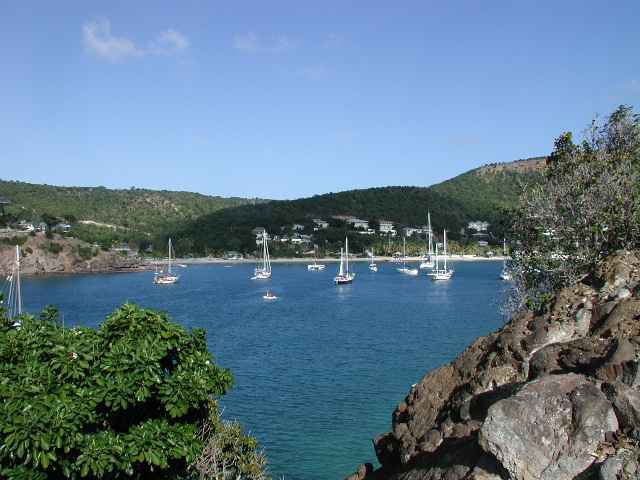
Freeman Bay, English Harbour, Antigua
|
We arrived on the morning of 8th February and slung
our hook in this idyllic bay. English Harbour is beautiful, sailing
heaven. One side is "Nelson's Dockyard" a national
park containing buildings from the colonial times. Our first trip
was there to immigration, customs and the port authorities. We had a
weekend at anchor in Freeman Bay to relax and rest between our crossing and haul
out on Monday morning.
On Sunday we were having a spot of lunch in the
cockpit when a friendly chap came sailing by in his Optimist dinghy.
Turns out he'd seen our Welsh dragons. His name is Gordon, he's from
Swansea but has lived in Antigua on and off for five years. He also
happened to be a marine engineer working at one of the engineering companies
here. With our propshaft problems, it was as if someone had sent us
an angel! Within 10 minutes of his cup of tea, he was in the engine
room with Phil giving advice!
|
|
Later the same day we went, as everyone does on a
Sunday, to the party at Shirley Heights. A barbecue on the hill
overlooking the whole of English Harbour, where very, very strong rum punch is
served and there's a steel band followed by a reggae band. Its a
great atmosphere. We took the difficult option walking up the
hill but it was great to be walking in the countryside again after 25 days of
seeing nothing but sea. At the party we met some new friends, Brad a
Canadian pilot, who's married to Melanie from Tobago and Tyler their little
boy. We got on really well with them and also an American couple
here on vacation and had a very enjoyable evening.
Despite the rum punches we had to get up early
the next morning for our haul out and back to work.......
|
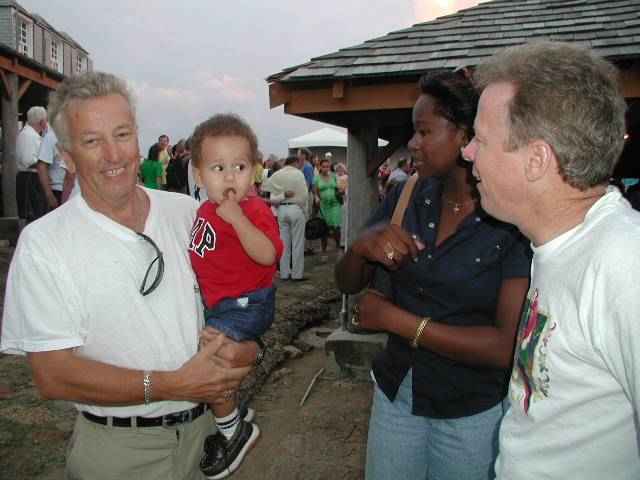
Shirley Heights Party
with our new friends. |
|
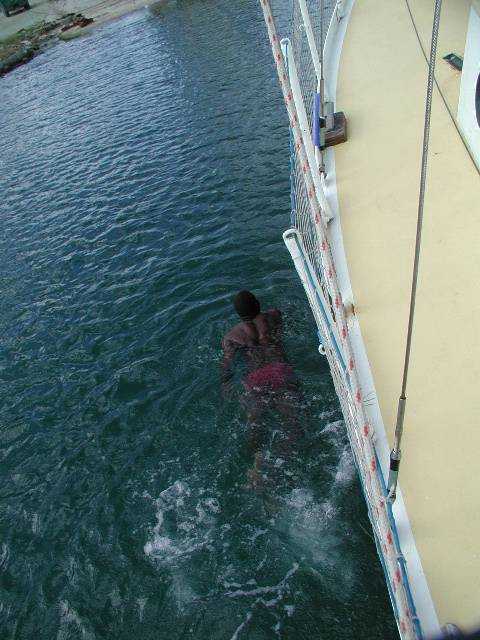
James checking the
positioning of the boat on the trailer.
|
We were hauled out on Monday morning on a slipway,
which was a new experience for us but far less nerve-wracking that a travel
hoist. You don't have that moment when you think the slings might break
under the strain! They did have some trouble with the weight
of the boat, their tractor couldn't pull her up the steep part of the
ramp. Eventually they found a solution by hooking a cable up to the
railway type slipway they use for big boats and using that to take some of the
strain. Within a couple of hours we were safely settled ashore and
ready to start work.
|
|
First priority was to sort out the propshaft.
First we had to get the propeller off and then try to find a way to get the
propshaft out past the redesigned rudder. We had to cut out the
rudder stop on one side, take up the wood on the diving platform and cut out a
piece of steel there too before we could turn the rudder enough to get out the
propshaft. Luckily though we managed it without craning off the
rudder. Then the propshaft wouldn't come out of the coupling
on the engine. This took more ingenuity and some brute force but
finally was loosened after half a day.
|
| Once
the propshaft was out, the problem was clear. As suspected the
problem was with the cutlass bearing (a round bearing with a brass outer
and rubber inner which is around the propshaft to stop the shaft moving up
and down and keep it straight). Somehow the brass and rubber
on ours had parted company. The brass was still in position but the
rubber had wriggled out and right up the propshaft inside the boat,
leaving the propshaft free to move and rattle about. How this
happened is a mystery but at least the rubber hadn't worn away which would
have meant something was out of alignment on the engine and would have
been much more difficult to solve. Anyway Phil got it fixed quickly
and a new bearing in place, then we set to work on the underwater
paintwork, whilst the boat was out of the water. Some sanding
was required on bad patches and of course the antifouling paint we used
wasn't available here as they only use the banned in the UK and USA types
which are far more effective, so we needed a barrier coat before the two
coats of antifouling paint. A lot of work but it all got done
and a few other jobs too in eight days and we're now back in the
water. The people at Antigua Slipway were very helpful. |
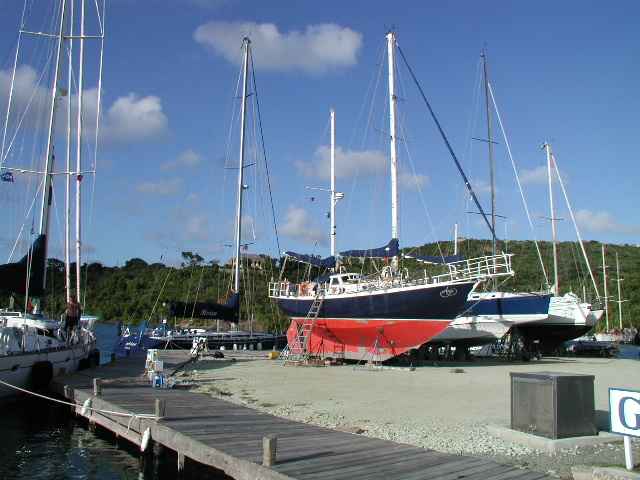
Work in progress. At
least the floor has stopped rocking now!
|
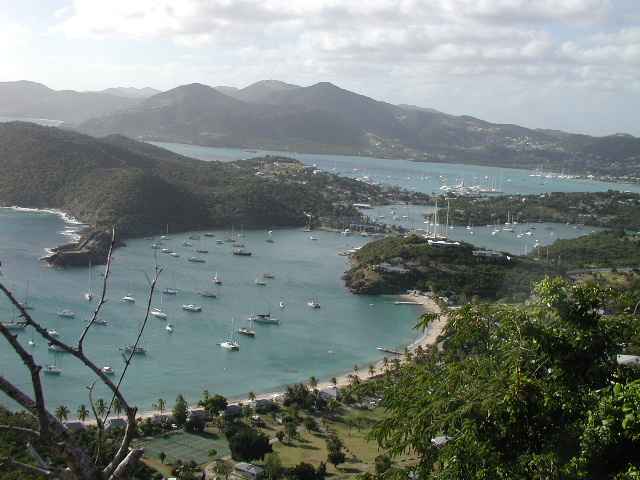
View of English Harbour
and Falmouth (in the background) from Shirley Heights |
We took
half a day off from working to catch the bus to St. Johns, the
capital. The bus was an adventure, started off as a 10 seater
but on the way folding seats kept appearing and more and more people piled
on. The only problem was if the person at the back of the bus
wanted to get off, everybody else had to get off and get back on
again. St. Johns was very busy with everybody out
shopping. We headed to the big supermarket for some supplies
as the shops in English Harbour and Falmouth have a very limited selection
and very high prices specially for rich boat
owners.
We left English Harbour on 26th February
and headed to the west coast of Antigua, where we found a deserted
anchorage in Five Islands Bay. One or two boats came in to stay
overnight but mostly we had the place to ourselves. |
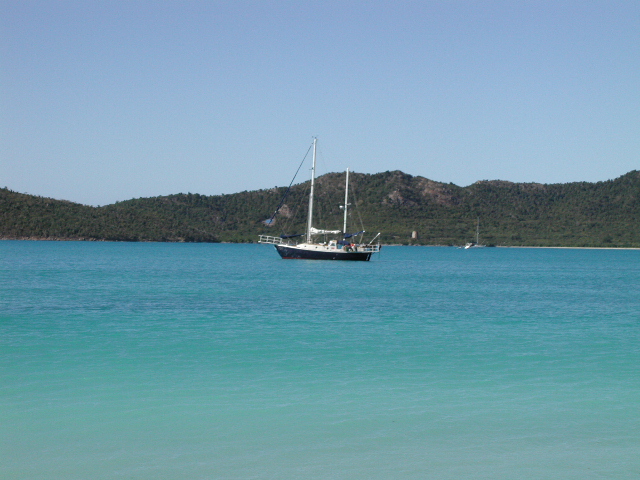
Five Islands Bay |
The
bay had several beaches and we made expeditions to a couple in our dinghy
on the first day. The swell made landing on the beach
in the dinghy very exciting and we decided not to stay long before moving
to a different one.
The
boat which arrived a little later and dropped off the naked honeymooners
on the same beach didn't seem to have the same problem. I
wonder what they were up to behind that big rock!
We called into Jolly Harbour to clear
immigration and pick up water and then headed off on overnight passage to
St. Barts on Thursday 28th February, after a couple of restful days at
anchor.
|





